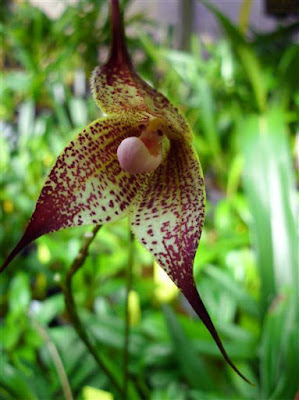Dracula ligiae is native to the Cordillera Occidental de Colombia. For the first time these plants were found in Medellin. Since then, they were also found in the Western Cordillera near Frontino in the Antioquia department, at an altitude of 2050 m...
Dracula ligiae also called as Ligia's Dracula, is a species of the genus Dracula. This species was described by Carlyle August Luer & Rodrigo Escobar in 1989.
IDENTIFY DRACULA LIGIAE
Dracula ligiae is native to the Cordillera Occidental de Colombia. For the first time these plants were found in Medellin. Since then, they were also found in the Western Cordillera near Frontino in the Antioquia department, at an altitude of 2050 m.
It is a small to medium sized, cool to cold growing epiphyte, which reaching a height of 19-32.5 cm, with erect, stout, 4.0-5.5 cm long ramicauls enveloped basally by 2 to 3, loose, tubular sheaths and carrying a single, apical, erect, thinly coriaceous, carinate, obovate, acute, gradually narrowing below into the conduplicate, petiolate base, 15-27 cm long and 3.0-4.5 cm wide leaf.
Ligia's Dracula blooms in the spring and fall on a stout, erect, 7 cm long, loose, successively few flowered, racemose inflorescence arising from low on the ramicaul and carrying a few distant bracts as well as floral bracts. The outer whorls are light yellow with numerous purple-brown dots that dense at the apexes and merge into several longitudinal lines towards the base of the petal. They are covered with warts with short yellow hairs inside and all have long, slender tails growing out of the tips. The inner coat flakes are ivory in color and marked with brown spots. The lip is yellowish with an epichile colored pink and hypochile with brown spots. The spine is light yellow.
DRACULA LIGIAE CARE AND CULTURE
Cultural information should only be used as a guide, and should be to be adapted to suit you. Your physical location; where you grow your plants, how much time you have to devote to their care, and many other factors, will need to be taken into account. Only then can you decide on the cultural methods that best suit you and your plants.
Light:
Dracula ligiae needs a light level of 12000-18000 lux. The light should be filtered and dispersed, and the plants should not be exposed to direct sunlight in the afternoon hours. Strong air movement should be ensured all the time.
Temperature:
It is a plant with moderate thermal requirements. Throughout the year, the average day temperature is 23-26 ° C, the average night temperature is 11-13 ° C, with a daily amplitude of 11-14 ° C.
Humidity:
Ligia's Dracula needs a light level of 70-75% throughout the year.
Substrate, growing media and repotting:
Dracula ligiae can be grown mounted in hanging baskets or in mesh containers or grown in hanging baskets lined with sphagnum moss and filled with loose, quickly drying substrate containing chopped sphagnum or perlite, which retain moisture, and with charcoal, which prevents acidification of the substrate and relaxes it.
This species recommend annual repotting. When using substrate with only loosely packed sphagnum from New Zealand, the plants should be repotted every 9-12 months, especially if the water used is highly mineralized. When the sphagnum begins to decompose, the balance is dramatically disturbed in the content of trace elements, which can kill plants. However, whatever substrate is used, it should be replaced when it is decomposing, or when the plant grows out of the container. Repotting is best done when new roots begin to grow. Then the plants are able to stabilize the most quickly. This is usually done at the end of winter or early spring, but it can be done in any period between autumn and spring, as long as it does not interfere with flowering.
Watering:
Rainfall is moderate to heavy for almost a full year, with a 2-3 month drier winter period. Dracula ligiae should be abundantly watered during active growth, but excellent drainage should be ensured so that the substrate within the roots is not degraded or soggy.
Fertilizer:
During the active growth, the plants should be fertilized every week 1/4-1/2 of the recommended dose of fertilizer for orchids. You can use balanced fertilizer throughout the year, but also can use fertilizer with increased nitrogen content from spring to mid summer, and then in the late summer and autumn, use a fertilizer with a higher content of phosphorus.
Rest period:
Dracula ligiae in winter need less water, but they should not dry up completely, nor be dry for a longer period. In general, enough frequent fogging in the early morning between rare waterings is enough. Fertilization should be reduced or eliminated until new growths appear and a more abundant spring watering begins.















COMMENTS